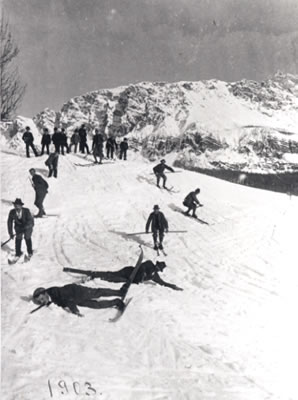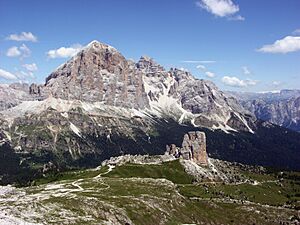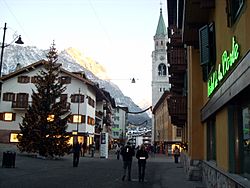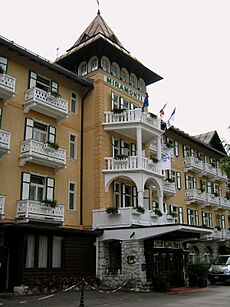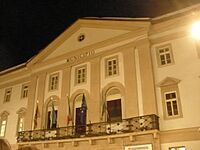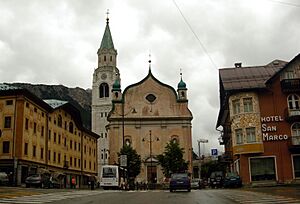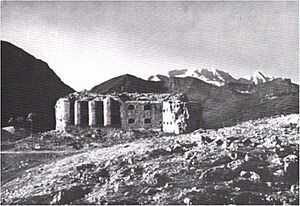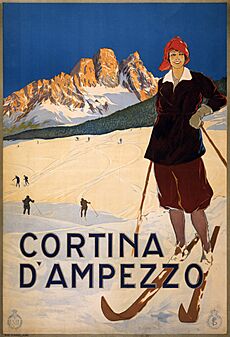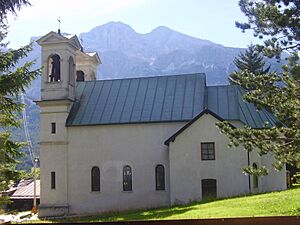Cortina d'Ampezzo facts for kids
Quick facts for kids
Cortina d'Ampezzo
Anpezo / Ampëz (Ladin)
|
|
|---|---|
| Comune di Cortina d'Ampezzo/Comun de Anpezo | |
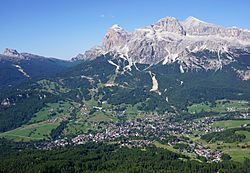
View of Cortina d'Ampezzo
|
|

The Comune of Cortina d'Ampezzo shaded red in the Province of Belluno
|
|
| Country | Italy |
| Region | Veneto |
| Province | Belluno (BL) |
| Frazioni | see list |
| Area | |
| • Total | 254.51 km2 (98.27 sq mi) |
| Elevation | 1,224 m (4,016 ft) |
| Population
(1 January 2021)
|
|
| • Total | 5,669 |
| • Density | 22.2742/km2 (57.690/sq mi) |
| Demonym(s) | Ampezzani |
| Time zone | UTC+1 (CET) |
| • Summer (DST) | UTC+2 (CEST) |
| Postal code |
32043
|
| Dialing code | 0436 |
| Patron saint | St. Philip and James |
| Saint day | 3 May |
Cortina d'Ampezzo, often called simply Cortina, is a beautiful town in the heart of the Dolomites mountains in Northern Italy. It's located in the Veneto region, by the Boite River. Cortina is famous as a fancy place for both summer and winter sports. People love its skiing trails, amazing scenery, great places to stay, cool shops, and fun after-ski activities. It's a popular spot for celebrities and important Italian families.
Cortina has a long history. It was once part of the Republic of Venice. Then, for many years, it was ruled by the Habsburg family from Austria. It briefly changed hands during the time of Napoleon, but went back to Austria until 1918. From the 1800s, Cortina became known for its crafts. Visitors from Britain and Germany loved the handmade items. These included wooden furniture, special tiled stoves, and things made from iron, copper, and glass.
Today, tourism is very important for Cortina's economy. The town's population grows a lot in winter, from about 7,000 to 40,000 people. Cortina has a main church, the Basilica Minore dei Santi Filippo e Giacomo, built in the 1700s. There are also interesting museums like the Rinaldo Zardini Palaeontology Museum (about fossils), the Mario Rimoldi Modern Art Museum, and the Regole of Ampezzo Ethnographic Museum (about local culture).
Cortina d'Ampezzo was supposed to host the 1944 Winter Olympics, but they were canceled because of World War II. However, it did host the 1956 Winter Olympics and many other winter sports events. Cortina will host the Winter Olympics again in 2026, sharing the event with Milan. The town has a professional ice hockey team called SG Cortina. It's also the start and end point for the yearly Dolomites Gold Cup Race. Many famous movies have been filmed here, including The Pink Panther (1963), For Your Eyes Only (1981), and Cliffhanger (1993).
Contents
Exploring Cortina's Past
Ancient Times: Early Humans and Romans
In 1987, an old tomb was found in the mountains south of Cortina. This showed that people lived here as far back as 6,000 BC. Around 600 BC, the Etruscans influenced the area. Later, around 300 BC, the Romans took over. They called the area Amplitium, meaning "wide," which is where the name Ampezzo comes from.
From Middle Ages to the 1800s
After the Roman Empire fell, not much is known about the area until the Middle Ages. People likely moved to the valleys, including Ampezzo, to escape invaders. In the Middle Ages, Ampezzo was part of the Holy Roman Empire. In 1420, the Republic of Venice took control. Then, in 1508, the Habsburgs (from Austria) conquered it. By 1511, the people of Ampezzo promised loyalty to the Austrian Emperor.
In 1797, Napoleon allowed Austria to keep Cortina. But in 1810, he added Ampezzo to his empire after French troops burned the town. This didn't last long. Austria took it back in 1813 and kept it even after Venice became part of Italy in 1866. Cortina became known as a healthy place to visit, free from diseases like cholera.
In 1874, the Ampezzo forest became owned by a special group. Even though it was Austrian until 1920, most people in Ampezzo spoke Ladin. This is a special language related to Rhaeto-Romance languages.
The 1900s: Wars and World Fame
When Italy joined World War I in 1915, many men from Cortina were fighting for Austria-Hungary. About 669 local men, mostly young or old, tried to defend against Italian troops but had to retreat. The mountains around Cortina saw many battles. After the war, in 1920, Cortina became part of Italy. In 1923, it joined the province of Belluno in the Veneto region.
The town was renamed "Cortina d'Ampezzo" after one of its villages. This name means "Curtain of the Ampezzo Valley." During World War II, Cortina was an important storage area for supplies. It was almost attacked in 1945, but bad weather stopped it.
Cortina was already a popular spot for British tourists in the late 1800s. After World War I, it became a resort for wealthy Italians too. Cortina was chosen to host the 1944 Winter Olympic Games, but they were canceled due to the war. However, hosting the 1956 Winter Olympics made Cortina famous worldwide. Tourism greatly increased. The Ford Cortina car, very popular in the UK in the 1970s, was named after this town.
Geography and Weather in Cortina
Cortina is located in the middle of the Ampezzo valley. It's surrounded by the stunning Dolomites mountains. The Boite River flows right through the town. The mountains here are described as "craggy" and "soaring," looking like a huge coral reef. Cortina is between other valleys and towns. It used to be many small villages, but tourism made it grow.
Some of the famous mountains around Cortina include Tofane to the west and Cristallo to the northeast. Monte Antelao is the highest mountain in the Ampezzo Dolomites. The town center is about 1,224 meters (4,016 feet) high. The closest high peak is Tofana di Mezzo, at 3,244 meters (10,643 feet). The area has many fast-flowing rivers, streams, and small lakes. These fill up when the snow melts in summer. You might see animals like marmots, roe deer, and chamois here. Sometimes, wolves, bears, and lynx are also spotted. Much of Cortina is part of the "Natural Park of the Ampezzo Dolomites."
Cortina's Climate
Cortina d'Ampezzo has a cold alpine climate. It has short, mild summers and long, very cold winters. Winters can be snowy and changeable. In late December and early January, some of Italy's coldest temperatures are found here. Other seasons are usually rainy, cool, and windy. In summer, temperatures can reach 25°C (77°F).
People and Languages
Cortina's population grew steadily until the 1960s. Then it decreased, but has started to recover recently. With about 6,112 people in 2008, it's the seventh largest town in its province. Most families have about 2.2 people.
Not many foreign residents live in Cortina d'Ampezzo. They make up about 4.9% of the total population. This is a smaller percentage compared to other towns and regions in Italy.
Local Language: Ladin
Besides Italian, most people in Cortina speak Ampezzano. This is a local version of Ladin. Ladin is now recognized as its own language, not just a dialect. It's a Rhaeto-Romance language, similar to Romansh spoken in Switzerland. Keeping their local language alive is a source of pride for the people of Cortina. It shows their connection to their heritage. Local authorities are even starting to use Ladin on street signs.
Cortina's Economy and Shopping
Since the 1800s, Ampezzo has been known for its crafts. In 1874, an Art Institute was opened to teach wood and metalwork. Early British and German tourists loved the handmade products. Some local items were even thought to have magical qualities! The town was skilled at making wooden furniture, tiled stoves, and items from iron, copper, and glass.
Today, Cortina's economy relies on tourism, especially in winter. The town's population can jump from 7,000 to 40,000 during peak times. Lonely Planet calls Cortina "one of Italy's most famous, fashionable and expensive ski resorts." It has excellent facilities for skiing, skating, sledding, and climbing. It's also great for hiking.
Cortina d'Ampezzo has many fancy fashion stores like Bulgari and Gucci. You can also find artisan shops, antique stores, and craft shops. There are many stores selling mountaineering equipment too. A famous shopping spot is La Cooperativa di Cortina, founded in 1893. This large shopping center has everything from sweets to newspapers, toys, gifts, and ski gear. It was one of the first cooperatives in Italy and employs about 200 people.
The five-star Miramonti Majestic Grand Hotel is over 100 years old. It was once a hunting lodge and was featured in a James Bond movie. Other notable hotels include Hotel Cornelio and Hotel Montana. There are also mountain hostels with restaurants nearby.
Famous Places to See
The Town Hall is a palace in the Tyrolean style, located near the Bigontina River. Piazza Angelo Dibona is the main square. It has important buildings like the Ciasa de ra Regoles. This building was once a primary school and now holds offices for the local community council. The square is named after a famous local mountain guide, Angelo Dibona.
Museums to Explore
Cortina has three main museums, managed by the Regole d'Ampezzo:
- The Rinaldo Zardini Palaeontology Museum was started in 1975. It has hundreds of fossils found in the Dolomites. These fossils show that these high mountains were once at the bottom of a tropical sea, full of sea creatures.
- The Regole of Ampezzo Ethnographic Museum is in an old sawmill. It displays items from daily life, farming tools, and traditional clothing from the valley.
- The Mario Rimoldi Modern Art Museum opened in 1941. It has over 800 artworks by important Italian artists from the 1900s. It also hosts special temporary exhibitions.
You can also visit the Great War Tour. This is an 80 km (50 mi) route through the mountains. It includes the Great War Open Air Museum with trenches and tunnels. You can ski it in winter or walk/bike it in summer.
Churches and Shrines
The Basilica Minore dei Santi Filippo e Giacomo is the main church. It was built between 1769 and 1775 on the site of older churches. It has a tall wooden altar and beautiful frescoes on the ceiling by Luigi Ghedina.
The Chiesa della Madonna della Difesa was built in 1750. Its front has a detailed fresco of the Madonna. Inside, it's decorated with statues, paintings, and colorful marble.
The Cappella della Beata Vergine di Lourdes (Chapel of Our Lady of Lourdes) was finished in 1907. It's a small church with interesting sculptures.
The Cappella di Sant'Antonio da Padova was completed in 1791. It was rebuilt after a fire in 1809. It has wooden busts and a richly designed altar.
Sacrario militare di Pocol (also called Ossario di Pocol) is a cemetery and shrine. It's located high up at 1,535 meters (5,036 feet). It was built in 1916 as a military cemetery. In 1935, a shrine was added to remember the thousands who died in World War I in the Dolomites. It's a large stone tower that you can see from the valley below. The body of General Antonio Cantore, a war hero, rests in a crypt here.
Castles and Forts
The Castello de Zanna is a small fortress. It has low, white walls and two white corner towers. It also has a small chapel. Building started in 1694 but was stopped. It was burned by French troops in 1809 but has since been restored.
Forte Tre Sassi (or Forte Tra i Sassi) is a fortress built in 1897 by Austria-Hungary. It's located between two mountains, controlling a key pass. It was part of a large system of Austrian forts. The fort was damaged by Italian bombing in 1915. Its ruins were restored in the 2000s. Now, it's a museum with items from World War I.
Castello di Botestagno was a medieval fort on a rock. It was built to control three valleys. It might have been built as early as the 600s. It was held by Germans, then other groups, and finally by the Habsburgs. In the 1700s, the castle lost its importance. Today, almost nothing is left of it, only some foundations covered by plants.
Culture and Arts
Cortina d'Ampezzo has always welcomed writers, thinkers, poets, and publishers. Famous people like Ernest Hemingway and Saul Bellow spent their holidays here. They took part in the town's cultural life. This has led to many literature festivals and book events, like "Una Montagna di Libri" ("A Mountain of Books"). This festival happens twice a year since 2009.
Music is very important to the people of Cortina. You can often find young musicians playing in the streets. Every year, in late July and early August, Cortina hosts the Dino Ciani Festival and Academy. This event honors the famous Italian pianist Dino Ciani. Young pianists from all over the world come here to learn from top performers. The Festival of the Bands is another yearly music event. It features brass bands from Italy and other countries in late August. Cortina's own band, dressed in traditional costumes, is a main attraction. It dates back to 1861.
The main religion in Cortina d'Ampezzo is Roman Catholicism. There are also small communities of Eastern Orthodox Christians and Muslims, mostly from recent immigration. A group of Jehovah's Witnesses also has a meeting place here.
The beautiful scenery around Cortina has been used for many movies. These include mountain climbing scenes for Cliffhanger and Krull. The town was also a main location for the 1981 James Bond film For Your Eyes Only. In the movie, James Bond meets a character at the top of Tofana and stays at the Hotel Miramonti. Many action scenes were filmed in the town, including a famous ski chase.
Sports and Fun Activities
| Cortina d'Ampezzo | |
|---|---|
 |
|
| Lua error in Module:Location_map at line 420: attempt to index field 'wikibase' (a nil value). | |
| Location | Italy |
| Nearest city | Belluno |
| Vertical | 1,611 meters (5,285 ft) |
| Top elevation | 2,930 meters (9,610 ft) |
| Base elevation | 1,224 meters (4,016 ft) |
| Runs |
|
| Longest run | 11 kilometers (6.8 mi) |
| Lift system |
|
| Lift capacity | 42,212 Passengers/hour |
| Total length | 120 km (70 mi) |
| Website | Cortina Dolomiti |
Cortina d'Ampezzo hosted the 1956 Winter Olympics. It was also supposed to host the 1944 Olympics, but they were canceled due to war. Cortina has hosted other world ski championships too. It tried to host the Winter Olympics again in 1988 and 1992 but didn't win.
Cortina d'Ampezzo hosted the FIS Alpine World Ski Championships 2021. It will also co-host the 2026 Winter Olympics and 2026 Winter Paralympics with Milan.
The town is home to SG Cortina, a professional ice hockey team. Cortina d'Ampezzo is also where the yearly Dolomites Gold Cup Race starts and ends. This is a historical race for cars on public roads.
Cortina d'Ampezzo is a great place for amateur skiers. It's part of the huge Dolomiti Superski area. Cortina itself has 115 km (71 mi) of ski runs and 34 lifts. It has snow coverage for over 95% of the season, from December to April. There are six ski schools and about 300 instructors. The Faloria-Cristallo-Mietres ski area has amazing views and runs for all skill levels, even children. The Tofane area offers more challenging runs from a height of 2,500 meters (8,200 feet). The longest run is the Armentarola piste, which is 11 km (6.8 mi) long.
You can also enjoy cross-country skiing here, including on an old railway line. In Cortina, you can try many other winter sports like curling, ski mountaineering, snowboarding, and sledding. In the summer, popular sports include trekking, trail running, biking, rock climbing, tennis, and golf. Cortina d'Ampezzo is known for its many via ferratas (climbing routes) in the surrounding mountains. The annual Lavaredo Ultra Trail is a series of international trail running races held here.
Delicious Food
Cortina d'Ampezzo offers amazing food that mixes local traditions with Austrian influences. You can enjoy tasty main dishes like "chenedi" and "Casunziei." There are also hearty meat dishes such as mushroom roast and "gröstl." For dessert, try delicious apple strudel and ricotta tart.
Getting Around Cortina
Cortina Airport was built for the 1956 Winter Olympics, but it's closed now. The town has its own bus service. It connects the center to nearby villages and cable car lifts. The closest airports are in Venice: Treviso Airport (138 km or 86 mi away) and Venice Marco Polo Airport (148 km or 92 mi away). Both are about two and a quarter hours away by road.
The train station for Cortina d'Ampezzo is Calalzo di Cadore, 37 km (23 mi) to the southeast. From there, you can take a bus to Cortina. The total trip to Venice by train and bus is about three and a half hours. There are also direct bus links from Venice Mestre and Padova railway stations.
Cortina d'Ampezzo used to be a main stop on the narrow-gauge Dolomites Railway. This line closed in 1964. However, in 2016, plans were announced to study building a new train line.
Famous People Connected to Cortina
Cortina d'Ampezzo has attracted many famous people. They often found inspiration for their creative work here. These include Italian novelists like Dino Buzzati and Goffredo Parise. Ernest Hemingway, a famous American writer, also came here in 1918 as an ambulance driver.
Other notable visitors include mountaineers like John Ball and Paul Grohmann. Famous athletes who visited or are from Cortina include skiers Kristian Ghedina and Toni Sailer, and bobsledder Eugenio Monti.
Some distinguished sportspeople from Cortina d'Ampezzo itself are skiers Enrico Colli and his brother Vincenzo Colli, and Giuseppe Ghedina. They competed in the 1924 Winter Olympics. Severino Menardi participated in the 1932 and 1936 Olympics. Stefania Constantini won a gold medal in curling at the 2022 Winter Olympics. Other local citizens include climbers Angelo Dibona and Lino Lacedelli, and the painter Luigi Gillarduzzi.
Cortina's Global Connections
Twin Towns
Cortina d'Ampezzo is twinned with:
See also
 In Spanish: Cortina d'Ampezzo para niños
In Spanish: Cortina d'Ampezzo para niños


